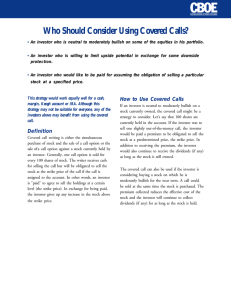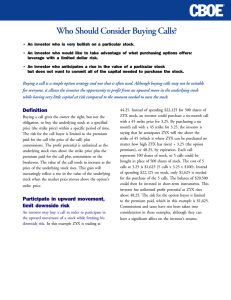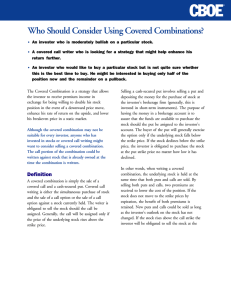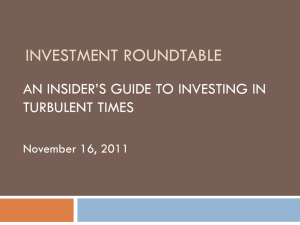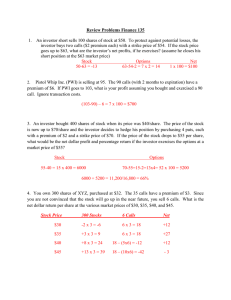Who Should Consider Using Covered Calls?
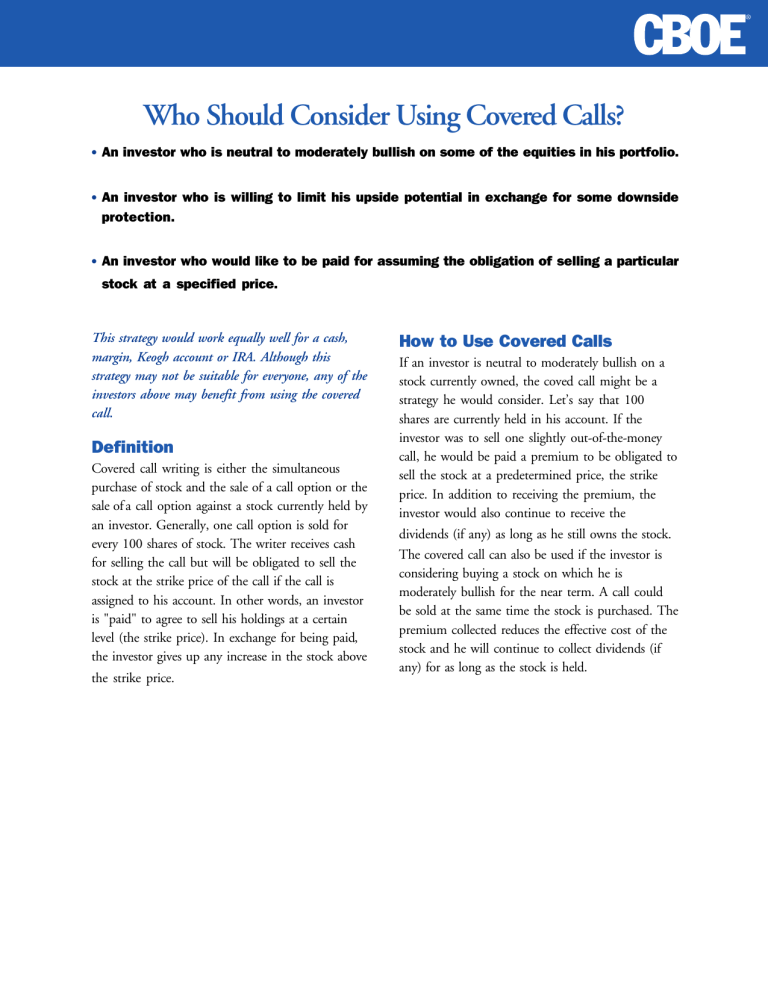
Who Should Consider Using Covered Calls?
• An investor who is neutral to moderately bullish on some of the equities in his portfolio.
• An investor who is willing to limit his upside potential in exchange for some downside protection.
• An investor who would like to be paid for assuming the obligation of selling a particular stock at a specified price.
This strategy would work equally well for a cash, margin, Keogh account or IRA. Although this strategy may not be suitable for everyone, any of the investors above may benefit from using the covered call.
Definition
Covered call writing is either the simultaneous purchase of stock and the sale of a call option or the sale of a call option against a stock currently held by an investor. Generally, one call option is sold for every 100 shares of stock. The writer receives cash for selling the call but will be obligated to sell the stock at the strike price of the call if the call is assigned to his account. In other words, an investor is "paid" to agree to sell his holdings at a certain level (the strike price). In exchange for being paid, the investor gives up any increase in the stock above the strike price.
How to Use Covered Calls
If an investor is neutral to moderately bullish on a stock currently owned, the coved call might be a strategy he would consider. Let’s say that 100 shares are currently held in his account. If the investor was to sell one slightly out-of-the-money call, he would be paid a premium to be obligated to sell the stock at a predetermined price, the strike price. In addition to receiving the premium, the investor would also continue to receive the dividends (if any) as long as he still owns the stock.
The covered call can also be used if the investor is considering buying a stock on which he is moderately bullish for the near term. A call could be sold at the same time the stock is purchased. The premium collected reduces the effective cost of the stock and he will continue to collect dividends (if any) for as long as the stock is held.
In either case the investor is at risk of losing the stock if it rises above the strike price. Remember, in exchange for receiving the premium for having sold the calls, the investor is obligated to sell the stock. However, as you will see in the following example, even though he has given up some upside potential there can still be a good return on the investment.
Stock ZYX currently is priced at 41.75, and the investor thinks this might be a good purchase. The threemonth 45 calls can be sold for 1.25. Historically, ZYX has paid a quarterly dividend of 25 cents. By selling the three-month 45 call the investor is agreeing to sell ZYX at 45 should the owner of the call decide to exercise his right to buy the stock. Keep in mind that the call owner may exercise the option if the stock is above 45, because he will be able to buy the stock for less than it is currently trading for in the open market.
But, as you will see, his return will be greater than if he had held the stock until it reached 45 and then sold it at that price.
Let’s take a look at what happens to a covered call position as the underlying stock moves up or down.
Commissions have not been taken into consideration in these examples; however, they can have a significant effect on your returns.
Buying 100 ZYX at 41.75 and Selling 1 Three-Month 45 Call at 1.25
I. ZYX remains below 45 between now and expiration--call not assigned.
The call option will expire worthless. The premium of 1.25 and the stock position will be retained. In effect you have paid 40.50 (which is also the breakeven price) for ZYX (41.75 purchase cost - 1.25 premium received for sale of call). This would be offset by any dividends that were received, which in this example would be 25¢.
When the ZYX call expires worthless, the covered call writer can sell another call going further out in time taking in additional premium. Once again, this produces an even lower purchase cost or breakeven.
If ZYX remains below 45 for an entire year, the investor can sell these calls four times. For this example we will make the hypothetical assumption that the price of the stock and option premiums remain constant throughout the year.
1.25 (Call Premium Received) x 4 = $5 in Premium + Any Dividends Paid = Total Income.
II. ZYX rises above 45 between now and expiration--call assigned.
The call buyer can exercise his right to buy the stock and the call seller will have to sell ZYX at 45, even though ZYX has risen above 45. But remember the call seller has taken in the premium of the call and has been earning dividends (if any) on the stock.
If ZYX stock is called away at expiration:
Receive: $45 for Stock $4,500.00
Less: Net Investment (Stock Cost - Premium Received)
[$4,175 - $125] ($4,050)
Return: 11.11% $450*
*In three months plus dividends (if any) received.
III. ZYX is right at 45 at expiration.
The seller of a call may be in situation I or II. The stock may be called away and the call writer will be obligated to sell ZYX at 45. Alternatively, the stock may not be called away. A call could then be sold going further out in time, bringing in additional premium and further reducing the breakeven point.
Summary
The covered call write is a strategy that has the ability to meet the needs of a wide range of investors. It can be used in your Keogh, margin, cash account or IRA against stock you already own or are planning on buying.
Currently, there are short-term options listed on more than 1,400 stocks and more than 350 of those stocks also have LEAPS ® , Long-term Equity AnticiPation Securities TM , which are simply long-term stock and index options. Today’s investor has a choice of short-term and long-term expirations, as well as multiple strike prices. This strategy is actually more conservative than just buying stock, due to the fact that you have taken in premium and lowered your breakeven price on the stock position. The covered write allows you to be paid for assuming the obligation of selling a particular stock at a specified price.
FREE interactive strategies are available at www.cboe.com
Options involve risks and are not suitable for all investors. Prior to buying or selling options, an investor must receive a copy of Characteristics and Risks of
Standardized Options . Copies may be obtained by contacting your broker, by calling 1-888-OPTIONS, or from The Options Clearing Corporation at www.theocc.com. In order to simplify the computations, commissions, dividends, fees, margin interest and taxes have not been included in the examples used in this document. These costs will impact the outcome of stock and options transactions and must be considered prior to entering into any transactions.
Investors should consult their tax advisor about any potential tax consequences. The strategy discussed above is strictly for illustrative and educational purposes only and is not to be construed as an endorsement, recommendation, or solicitation to buy or sell securities. LEAPS ® is a registered trademark and Long-term
Equity AnticiPation Securities SM is a service mark of Chicago Board Options Exchange, Incorporated (CBOE).
Copyright © 2012 CBOE. All rights reserved.
